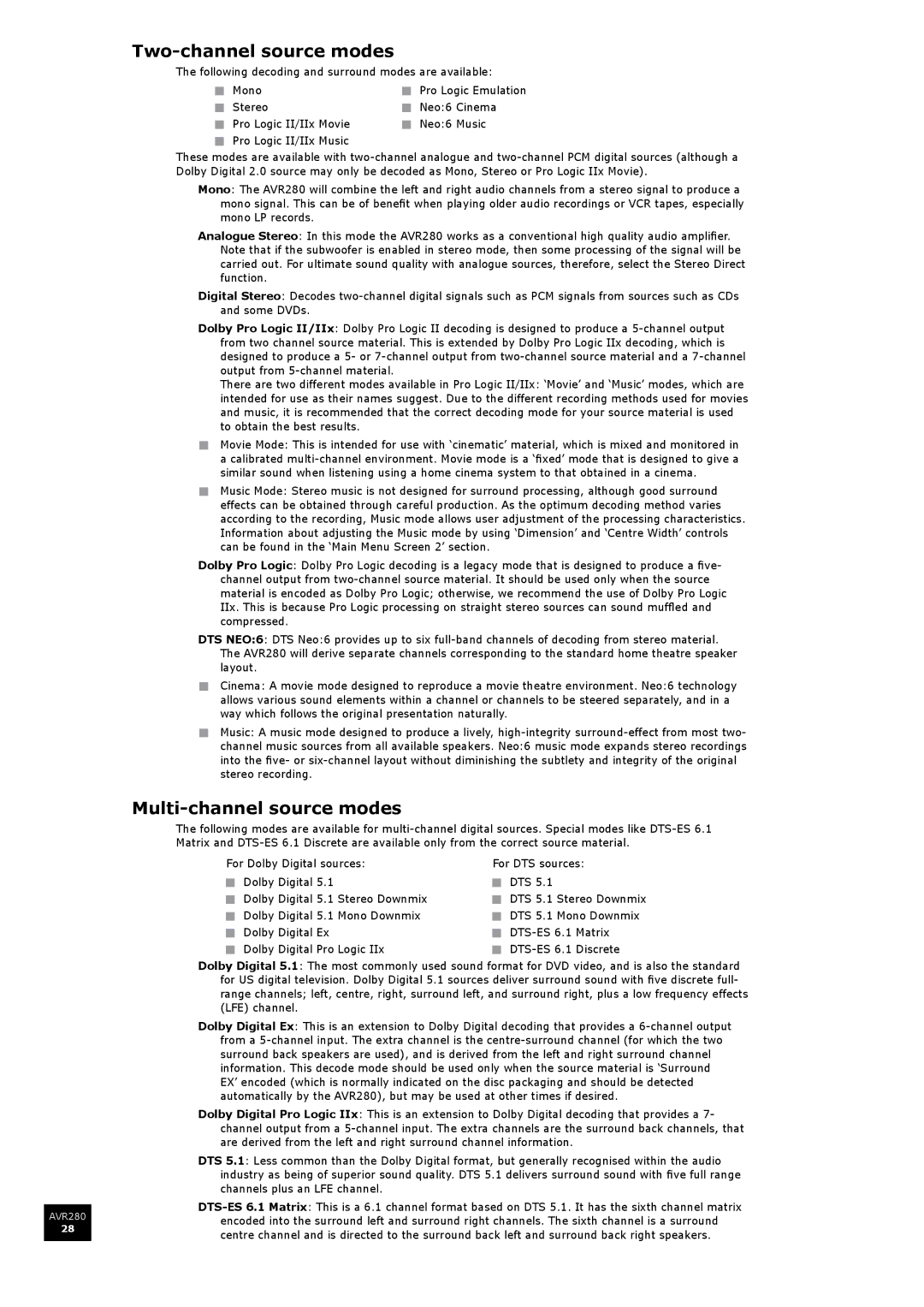Two-channel source modes
The following decoding and surround modes are available:
< Mono | < Pro Logic Emulation |
< Stereo | < Neo:6 Cinema |
< Pro Logic II/IIx Movie | < Neo:6 Music |
< Pro Logic II/IIx Music | |
These modes are available with two-channel analogue and two-channel PCM digital sources (although a Dolby Digital 2.0 source may only be decoded as Mono, Stereo or Pro Logic IIx Movie).
Mono: The AVR280 will combine the left and right audio channels from a stereo signal to produce a mono signal. This can be of benefit when playing older audio recordings or VCR tapes, especially mono LP records.
Analogue Stereo: In this mode the AVR280 works as a conventional high quality audio amplifier. Note that if the subwoofer is enabled in stereo mode, then some processing of the signal will be carried out. For ultimate sound quality with analogue sources, therefore, select the Stereo Direct function.
Digital Stereo: Decodes two-channel digital signals such as PCM signals from sources such as CDs and some DVDs.
Dolby Pro Logic II/IIx: Dolby Pro Logic II decoding is designed to produce a 5-channel output from two channel source material. This is extended by Dolby Pro Logic IIx decoding, which is designed to produce a 5- or 7-channel output from two-channel source material and a 7-channel output from 5-channel material.
There are two different modes available in Pro Logic II/IIx: ‘Movie’ and ‘Music’ modes, which are intended for use as their names suggest. Due to the different recording methods used for movies and music, it is recommended that the correct decoding mode for your source material is used to obtain the best results.
<Movie Mode: This is intended for use with ‘cinematic’ material, which is mixed and monitored in a calibrated multi-channel environment. Movie mode is a ‘fixed’ mode that is designed to give a similar sound when listening using a home cinema system to that obtained in a cinema.
<Music Mode: Stereo music is not designed for surround processing, although good surround effects can be obtained through careful production. As the optimum decoding method varies according to the recording, Music mode allows user adjustment of the processing characteristics. Information about adjusting the Music mode by using ‘Dimension’ and ‘Centre Width’ controls can be found in the ‘Main Menu Screen 2’ section.
Dolby Pro Logic: Dolby Pro Logic decoding is a legacy mode that is designed to produce a five- channel output from two-channel source material. It should be used only when the source material is encoded as Dolby Pro Logic; otherwise, we recommend the use of Dolby Pro Logic IIx. This is because Pro Logic processing on straight stereo sources can sound muffled and compressed.
DTS NEO:6: DTS Neo:6 provides up to six full-band channels of decoding from stereo material. The AVR280 will derive separate channels corresponding to the standard home theatre speaker layout.
<Cinema: A movie mode designed to reproduce a movie theatre environment. Neo:6 technology allows various sound elements within a channel or channels to be steered separately, and in a way which follows the original presentation naturally.
<Music: A music mode designed to produce a lively, high-integrity surround-effect from most two- channel music sources from all available speakers. Neo:6 music mode expands stereo recordings into the five- or six-channel layout without diminishing the subtlety and integrity of the original stereo recording.
Multi-channel source modes
The following modes are available for multi-channel digital sources. Special modes like DTS-ES 6.1 Matrix and DTS-ES 6.1 Discrete are available only from the correct source material.
For Dolby Digital sources: | For DTS sources: |
< Dolby Digital 5.1 | < DTS 5.1 | |
< Dolby Digital 5.1 Stereo Downmix | < DTS 5.1 Stereo Downmix |
< Dolby Digital 5.1 Mono Downmix | < DTS 5.1 Mono Downmix |
< Dolby Digital Ex | < DTS-ES 6.1 | Matrix |
< Dolby Digital Pro Logic IIx | < DTS-ES 6.1 | Discrete |
Dolby Digital 5.1: The most commonly used sound format for DVD video, and is also the standard for US digital television. Dolby Digital 5.1 sources deliver surround sound with five discrete full- range channels; left, centre, right, surround left, and surround right, plus a low frequency effects (LFE) channel.
Dolby Digital Ex: This is an extension to Dolby Digital decoding that provides a 6-channel output from a 5-channel input. The extra channel is the centre-surround channel (for which the two surround back speakers are used), and is derived from the left and right surround channel information. This decode mode should be used only when the source material is ‘Surround EX’ encoded (which is normally indicated on the disc packaging and should be detected automatically by the AVR280), but may be used at other times if desired.
Dolby Digital Pro Logic IIx: This is an extension to Dolby Digital decoding that provides a 7- channel output from a 5-channel input. The extra channels are the surround back channels, that are derived from the left and right surround channel information.
DTS 5.1: Less common than the Dolby Digital format, but generally recognised within the audio industry as being of superior sound quality. DTS 5.1 delivers surround sound with five full range channels plus an LFE channel.
DTS-ES 6.1 Matrix: This is a 6.1 channel format based on DTS 5.1. It has the sixth channel matrix encoded into the surround left and surround right channels. The sixth channel is a surround centre channel and is directed to the surround back left and surround back right speakers.
